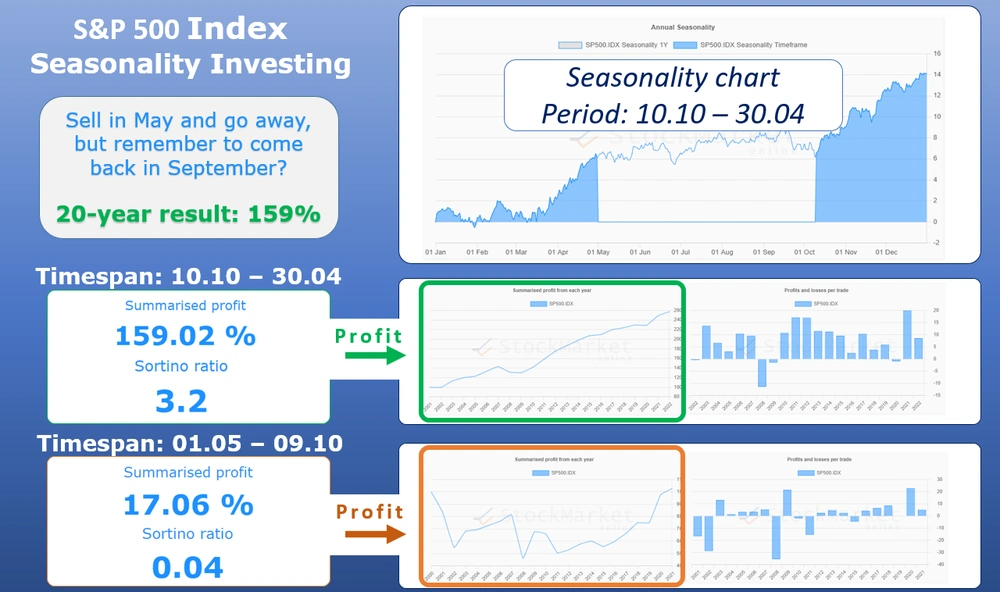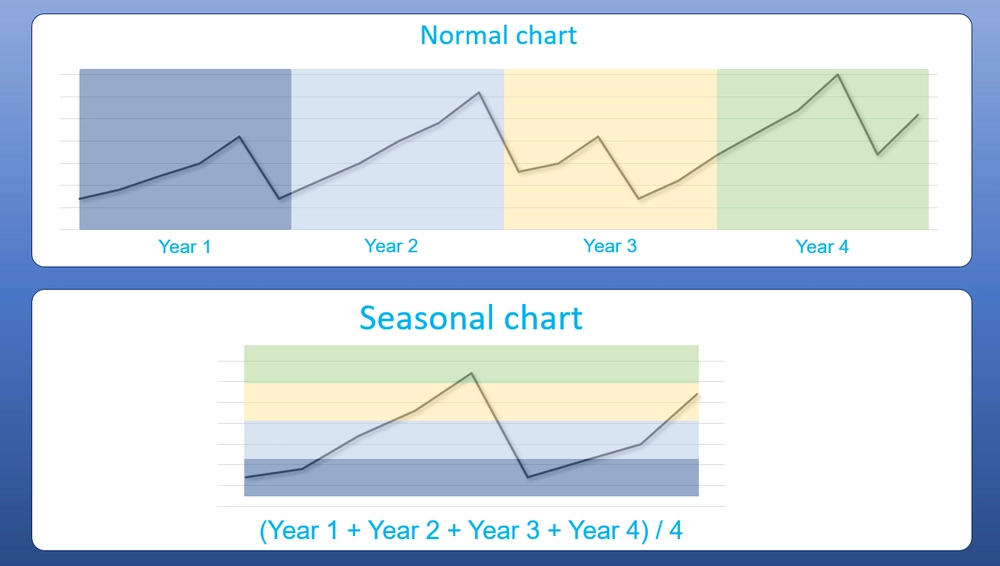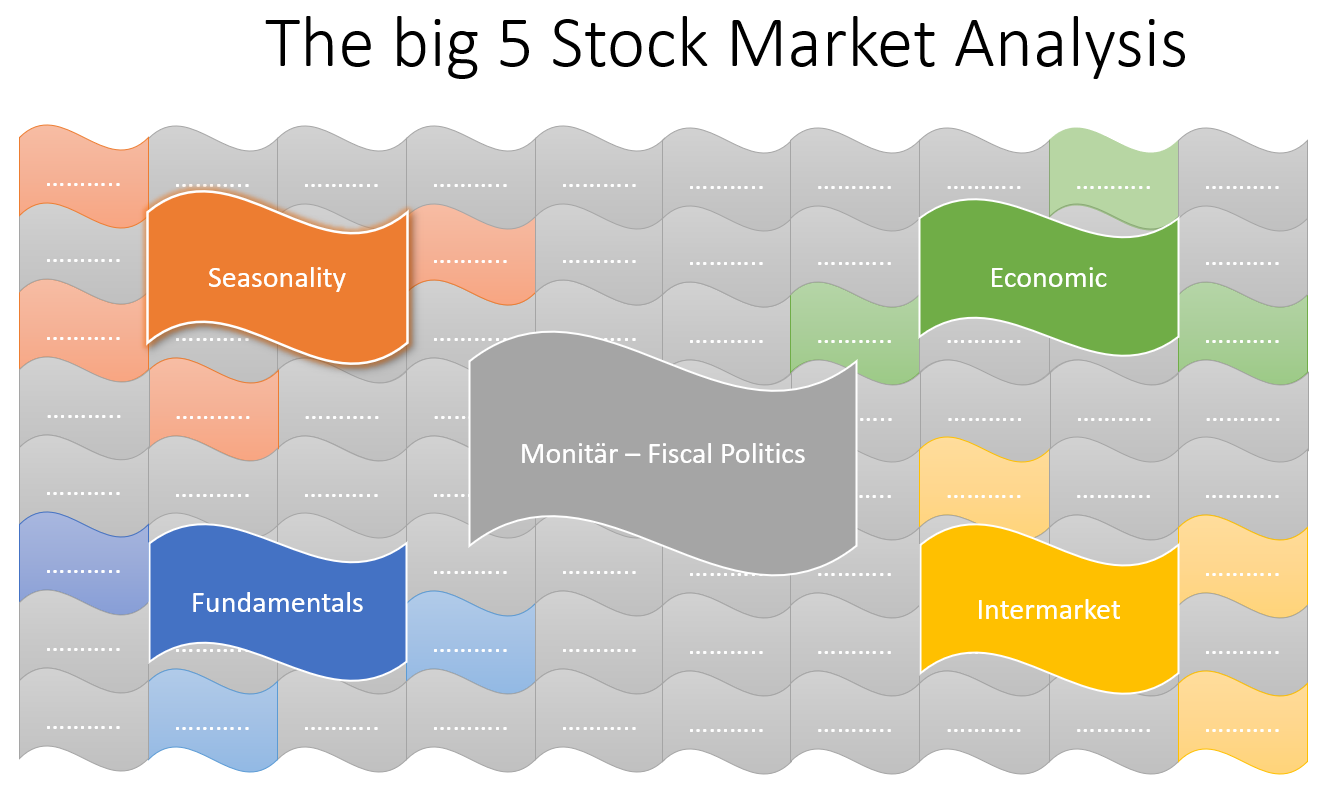What is Seasonility? How it works.
by SMO Team

Seasonality - What is it?
Do you know the expression "Sell in May and go away"? Or have you ever heard of a Santa Claus rally? Both result from the history of stock prices, in which prices tend to rise at Christmas and prices tend to fall from the month of May.
Both are findings from seasonal analysis. But seasonality can do much more. For seasonality can be used to calculate a wide variety of time periods such as months, weeks days or their combination.
The following picture shows the results if one had invested in the SP500 at different months.
- Investment from October 10 to April 30
- Investment from 01 May to 09 October
The two "Summarised profit" and the profit curves show the different results.

Seasonality Analyzer: S&P 500 ETF (SPY)
Why stocks, indices, commodities, currencies or economic indicators show seasonal patterns often has very different reasons.
For example, agricultural commodity prices are highly dependent on the weather. The seasons are a natural seasonality.
Another well-known example is retail sales, they usually peak during the Christmas season and decline after the holidays.
How it works.
For the calculation of seasonality, the historical prices of a share or an instrument are used to sum up the percentage movement of the individual days. In the calculation, all days are combined to form a year. This results in a yearly chart, which shows percentage movements seasonally.

Calculation of seasonality:
- Historical prices to sum up the percentage movement of the individual days
- All days are combined to form a year
- Results: seasonally chart
If you want to learn more about seasonality, you can find a more detailed description on Wikipedia.
Seasonality - Stock Market
For stocks, stock indices, commodities, etc., investor behavior influences seasonality. Investors are influenced by entrepreneurial profits.
Many companies are influenced by seasonal effects. For example, the travel industry, airline and hotel industry benefits from summer tourism.
Numerous supplier and service companies benefit at the beginning and end of the year from the budgets of the green companies.
At the beginning of the year new money is released and at the end of the year what is left is spent.
Especially in the fall and winter, stock prices rise the most. There are numerous reasons for this effect. While experts disagree on the reasons, they agree that the seasonal pattern exists and is a very good timing element.
Seasonality is one of the 5 major themes.
If you think of analyzing the stock market like putting together a puzzle of different sized pieces, seasonality and statistical analysis is one of the heavyweights.

Numerous studies have proven that seasonality exists in the financial markets and with the right strategy, very profitable gains are made.
Seasonality books
If you want to delve deeper into the topic, you can find several books at Amazon.
| Book Title | Link |
| The Profitable Truth About Seasonality: Breaking Trading Myths that Cost You Money | Amazon |
| Seasonality Revisited: The Use of Irregular Seasonality in Quantitative Time Series Analysis and Forecasting | Amazon |
| The Harriman Stock Market Almanac 2018: A handbook of seasonality analysis and studies of market anomalies to give investors an edge throughout the year | Amazon |
| Commodity Spread Trading - Take Advantage of the Seasonality: Volume 1 - Learn Spread Trading, the Best Way to Trade Commodity Futures; Book for Experienced Traders and Beginners. | Amazon |
| Seasonality: Systems, Strategies, and Signals | Amazon |
| Seasonal Concepts in Futures Trading: Turning Seasonality into Profits | Amazon |
Seasonality studies
The following list shows a number of studies on the topic of seasonality in the stock markets. The studies analyze trends over months, days to weekdays.
With our Seasonality Analyzer you can perform these analyses on your own.
The Seasonality Screener shows you new results every day. With the numerous filters functions the search result can be adapted to your needs.
-
Seasonality in the Cross Section of Stock Returns: The International Evidence
from: Steven L. Heston and Ronnie Sadka
In the "The Journal of Financial and Quantitative Analysis"
Vol. 45, No. 5 (OCTOBER 2010), pp. 1133-1160 (28 pages)
Published By: Cambridge University Press
https://www.jstor.org/stable/27919559 -
Stock market seasonality: International Evidence
from: Mustafa N.Gultekin N.Bulent Gultekin on sciencedirect.com:
https://www.sciencedirect.com/science/article/abs/pii/0304405X83900442 -
Several seasonal studies from Marshall Nickles,
from: Mustafa N.Gultekin N.Bulent Gultekin EdD on pepperdine.edu Business School
https://gbr.pepperdine.edu/author/nickles_m/ -
Several seasonal studies on sciencedirect.com
on sciencedirect.com
https://www.sciencedirect.com/search?qs=seasonal%20stock -
Agathee, U. S. 2008. Day of the week effect: Evidence from the stock exchange of Mauritius (SEM), International Research Journal of Finance and Economics 17: 7–14.
-
Alejandro, R. C. 2006. Day of the Week Effect on European Stock Markets, International Research Journal of Finance and Economics 2: 53–70.
-
Fama, E. F. 1956. The behavior of stock market prices, Journal of Business 38(1): 34–105. http://dx.doi.org/10.1080/13504850150504504
-
Gupta, K; Singh, B. 2009. Price Discovery and Arbitrage Efficiency of Indian Equity Futures and Cash Markets. NSE Research Paper
-
Nath, Golaka C. and Samanta, G. P. 2003. Integration between Forex and Capital Markets in India: An Empirical Exploration. Available from Internet: http://ssrn.com/abstract=475822
-
Sharma, J. L; Kennedy, R. E. 1977. A Comparative Analysis of Stock Price Behaviour on the B., London and New York Stock Exchanges, Journal of Financial and Quantitative Analysis 12: 391–413. http://dx.doi.org/10.2307/2330542
Summary
From our experience we can say. You would be surprised how many seasonal effects there are in the stock market. You can find many of these trends with our Seasonality Screener.
